Understanding Zero Liquid Discharge (ZLD)
Zero Liquid Discharge (ZLD) is a wastewater treatment process that aims to recover all water from a wastewater stream, leaving behind only solid waste. For industries like textiles, which are notoriously water-intensive and generate significant amounts of effluent, ZLD offers a sustainable solution to minimize environmental impact and comply with stringent regulations.
Why ZLD for Textile Industries?
The textile industry uses vast quantities of water in processes like dyeing, printing, and finishing. This results in highly contaminated wastewater containing dyes, chemicals, heavy metals, and high BOD/COD levels. Discharging this effluent without proper treatment can severely pollute water bodies and soil. ZLD systems help textile units:
- Meet strict environmental regulations and avoid penalties.
- Reduce freshwater consumption by recycling treated water.
- Recover valuable by-products from the waste stream.
- Enhance corporate social responsibility and public image.
Key Components of a ZLD System
A typical ZLD system for textile wastewater involves a combination of advanced treatment technologies:
- Pre-treatment: Screening, equalization, and primary treatment (coagulation, flocculation, sedimentation) to remove suspended solids and large particles.
- Biological Treatment: Activated sludge process, MBR (Membrane Bioreactor), or other biological methods to reduce organic load (BOD/COD).
- Membrane Filtration: Ultrafiltration (UF), Nanofiltration (NF), and Reverse Osmosis (RO) to remove dissolved solids, salts, and remaining contaminants.
- Evaporation/Crystallization: Technologies like Multiple Effect Evaporators (MEE) or Mechanical Vapor Recompression (MVR) to concentrate the reject stream from RO and crystallize salts, leaving pure water for reuse.
- Sludge Management: Handling and disposal of the solid waste (crystallized salts and sludge) in an environmentally safe manner.
Benefits for Textile Manufacturers
Implementing ZLD in textile operations brings numerous advantages:
- Water Conservation: Significant reduction in freshwater demand, leading to lower operational costs and increased water security.
- Environmental Compliance: Ensures adherence to stringent discharge norms, avoiding fines and legal issues.
- Resource Recovery: Potential to recover valuable chemicals or salts from the concentrated waste stream.
- Sustainable Image: Positions the company as an environmentally responsible entity, appealing to conscious consumers and investors.
WTT INTERNATIONAL specializes in designing, engineering, and implementing customized ZLD solutions for the textile industry, helping manufacturers achieve their sustainability goals while optimizing operational efficiency.
